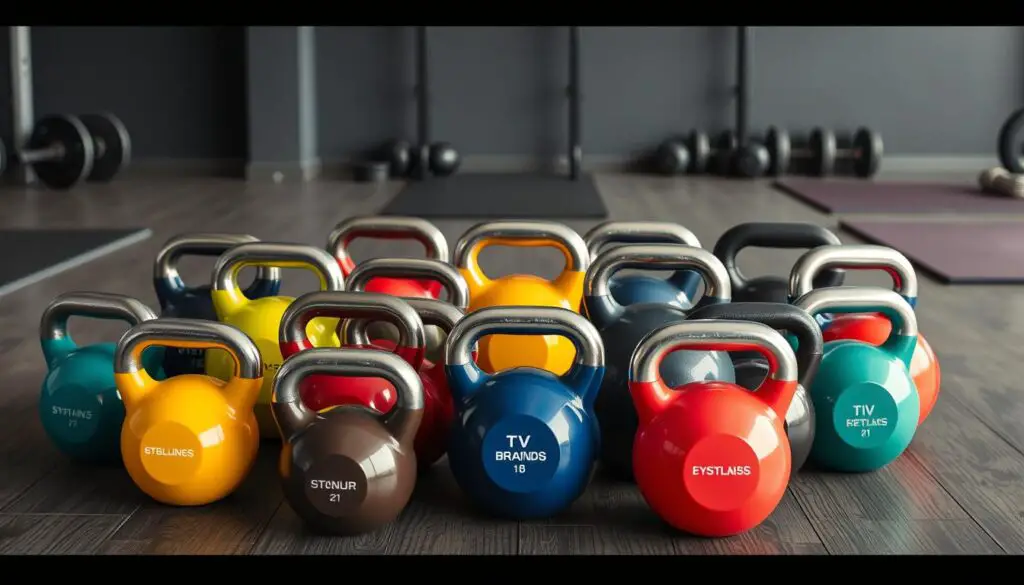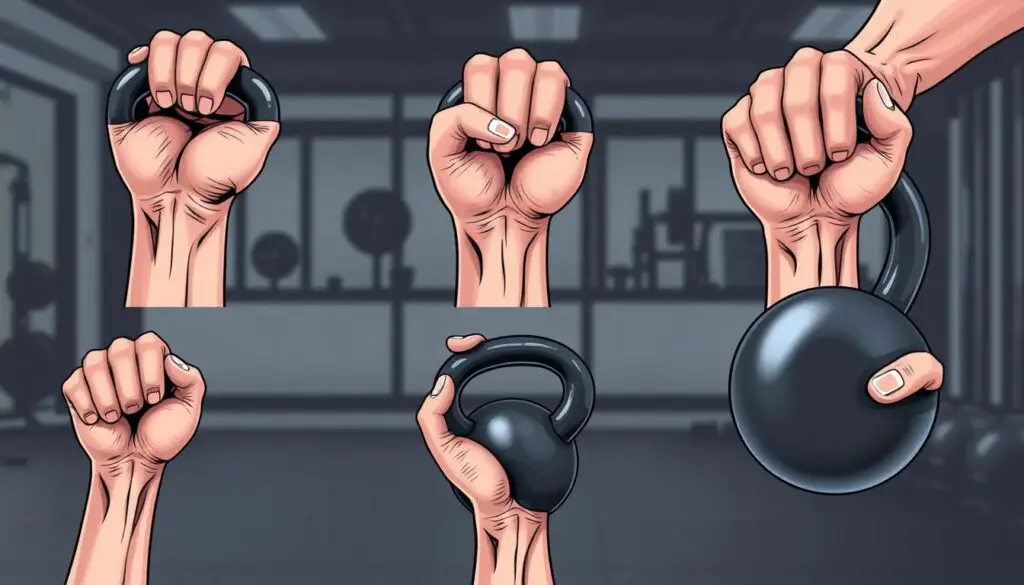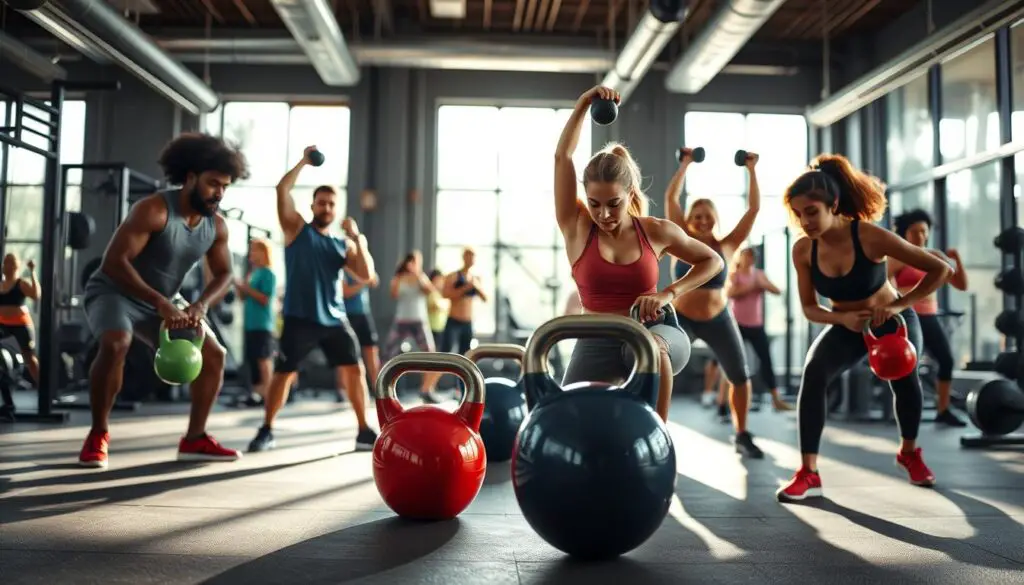Kettlebells are a great choice for anyone wanting to boost their strength training. They offer many benefits, making them perfect for both new and experienced athletes. Unlike regular weights, kettlebell exercises focus on dynamic movements. This helps work out many muscle groups at once, improving strength, endurance, and flexibility.
In this guide, we’ll cover all the kettlebell exercises you need to know. You’ll learn about their benefits and how to add them to your workout plan. This will help you get the most out of kettlebell training.
Key Takeaways
- Kettlebells provide a full-body workout improving strength and endurance.
- They enhance flexibility and support mobility through various exercises.
- Kettlebell workouts can aid in weight loss and fat burning.
- Suitable for all fitness levels, kettlebell training adapts to your needs.
- Learning proper techniques is key to maximizing kettlebell benefits.
Introduction to Kettlebells
Kettlebells are not just fitness tools; they have a deep history of kettlebells that goes back to ancient Greece. There, they were used for strength training as early as 500 BC. These early weights were key in building muscle and boosting athletic performance.
In the 20th century, kettlebells became a big part of Russian strength training. They were essential for building functional strength and endurance. Their popularity grew in the West too, thanks to their ability to mix strength training with cardio benefits.
Now, kettlebells are a big part of modern fitness. They’re loved for their versatility. Many fitness programs use kettlebells to improve strength, mobility, and overall fitness. Their design lets you work out many muscles at once, making them popular with athletes and fitness lovers.

The Benefits of Kettlebell Training
Kettlebell training is great for fitness lovers. It’s a full-body workout that boosts strength, endurance, flexibility, and more. Adding kettlebell exercises to your routine can make you stronger and more flexible.
Improved Strength and Endurance
Kettlebells help you get stronger and last longer. They work many muscles at once with their complex moves. This means you get stronger muscles and can keep going longer, thanks to the high number of reps and circuits you do.
Enhanced Flexibility and Mobility
Kettlebell exercises also make you more flexible and mobile. Swings, snatches, and Turkish get-ups help you move fully. This makes everyday activities and sports easier and lowers the chance of getting hurt.
Weight Loss and Fat Burning
Kettlebell workouts are perfect for losing weight and burning fat. They make your heart race, burning calories during and after the workout. Adding kettlebells to your routine can help you burn more calories even after you’re done exercising, aiding in weight loss.

Kettlebell Exercises for Beginners
Starting with kettlebell training can be rewarding. It helps build strength and coordination. It also sets a good routine for fitness.
Basic Kettlebell Movements
There are several exercises that are great for beginners. Key movements include:
- Kettlebell Swing: This exercise strengthens your lower body and boosts heart health. Stand with your feet shoulder-width apart. Swing the kettlebell between your legs, then push your hips forward to send it up to shoulder height.
- Goblet Squat: This movement is great for leg strength. Hold the kettlebell close to your chest. Squat down, keeping your back straight and feet flat.
- Deadlift: This targets your back muscles. Place the kettlebell on the ground in front of you. Bend at the hips to grab the handle, then stand up, keeping your shoulders back.

Safety Tips for Beginners
Keeping safe during your first kettlebell workout is key. Here are some tips to prevent injuries:
- Pick weights that are easy to handle. Start with light weights and increase them as you get better.
- Always warm up before starting. Simple stretches can get your body ready for the workout.
- Focus on balance and control in each move. Keeping the right form is key for kettlebell training.
- Pay attention to your body. Stop if you feel pain or discomfort.
Using these basic moves and safety tips will help you start strong with kettlebell exercises.
Advanced Kettlebell Workouts
Advanced kettlebell workouts focus on complex movements that test strength and coordination. They include exercises like the Turkish get-up and the kettlebell snatch. These exercises boost muscle endurance and fitness levels. They need precision and a good grasp of kettlebell training basics.
Practicing these complex movements regularly will improve functional strength and boost your metabolism.
Complex Movements for Experienced Lifters
For experienced lifters, complex movements are key to making progress. The Turkish get-up works many muscle groups and improves balance and stability. The kettlebell snatch combines explosive power with endurance, great for advanced workouts.
These exercises require proper form and technique to avoid injury and work well. Following a structured routine and slowly adding more weight will help increase strength and coordination.
Incorporating Kettlebells into HIIT
Kettlebell HIIT is a great way to burn calories quickly. It uses kettlebells in high-intensity circuits to work out different muscle groups. This approach improves overall fitness fast and keeps workouts fun.
Sample workouts include swings, snatches, and goblet squats, with intense effort followed by short rests. It’s perfect for those wanting quick fitness gains in a lively way.

Kettlebell Workout Routines
Kettlebell workouts are a great way to build strength and improve your fitness. A good full-body routine works many muscle groups at once. This makes each workout effective. Here are some routines for different fitness levels and specific workouts for arms and legs.
Full-Body Kettlebell Workout Routine
This routine targets all major muscle groups for balanced strength. It combines strength exercises with cardio to boost your fitness level.
| Exercise | Repetitions | Sets | Notes |
|---|---|---|---|
| Kettlebell Deadlift | 12-15 | 3 | Focus on your form |
| Kettlebell Swing | 15-20 | 3 | Engage core throughout |
| Kettlebell Goblet Squat | 12-15 | 3 | Keep chest up |
| Kettlebell Press | 10-12 per arm | 3 | Controlled movement |
| Kettlebell Row | 10-12 per arm | 3 | Keep back straight |
Targeted Muscles: Kettlebell Routines for Arms and Legs
Specific kettlebell exercises can target muscles in arms and legs. These workouts help improve muscle tone and strength.
- Kettlebell Curls: Focuses on bicep strength, aim for 10-12 repetitions per set.
- Kettlebell Lunges: Excellent for quads and glutes; perform 12-15 repetitions on each leg.
- Sumo Squats: Involves inner thighs and glutes, with 12-15 repetitions.
- Kettlebell Tricep Extensions: Targets the back of the arms; do 10-12 repetitions.
- Kettlebell Step-Ups: Engages legs and core; aim for 10-12 repetitions per leg.

For the best results, use these exercises in your kettlebell routine. Adjust them based on your fitness level and goals. Regular practice will improve your strength and overall fitness.
Choosing the Best Kettlebells
Choosing the right kettlebell is key to getting the most out of your workouts. Knowing the different types, like cast iron and competition kettlebells, helps you pick the best one for your goals. Each type has special features for different training needs and preferences.
Types of Kettlebells: Cast Iron vs. Competition
Cast iron kettlebells are a favorite among those who love fitness. They’re tough and versatile, great for many exercises. They have a wide handle that fits different grip styles. On the other hand, competition kettlebells are the same size everywhere, making it easier to do the same moves with any weight. This is a big plus for athletes in competitions.
- Cast Iron Kettlebells: Ideal for general fitness, strength training, and stability.
- Competition Kettlebells: Better for serious lifters focused on specific competitions or advanced techniques.
Weight Considerations for Different Fitness Levels
Finding the right kettlebell weight is key for training at any fitness level. Beginners should start with lighter weights to learn moves safely. As you get stronger, you can move up to heavier weights to boost strength and stamina.
| Fitness Level | Recommended Kettlebell Weight | Focus |
|---|---|---|
| Beginners | 10-15 lbs | Basic movement foundations |
| Intermediate | 15-25 lbs | Strength building and endurance |
| Advanced | 25+ lbs | Maximal strength and complex movements |

Top Kettlebell Brands to Consider
Choosing the right brand when buying kettlebells can greatly affect your workout. Many brands are known for their quality, reliability, and value. Here are some leading top kettlebell brands to look into:

| Brand | Features | Price Range | Customer Reviews |
|---|---|---|---|
| Rogue Fitness | High durability, competition standard | $$$ | Highly rated for performance and quality |
| Titan Fitness | Affordable, wide range of weights | $$ | Positive reviews for value and functionality |
| Kettlebell Kings | Professional design, powder coating | $$$ | Well-reviewed for comfort and usability |
| Body-Solid | Versatile, solid construction | $$ | Liked for quality and durability |
These brands offer some of the best kettlebells on the market today. When looking at options, consider the weight range, grip comfort, and build quality. Reading customer feedback can also help you choose the right kettlebell for your fitness goals.
How to Properly Hold and Swing a Kettlebell
Learning how to hold a kettlebell is key to doing swings right. A good grip helps with balance and control and keeps you safe from getting hurt. Knowing how to grip the kettlebell can really improve your workouts.
Grip Techniques for Balance and Control
Here are some top tips for a great kettlebell grip:
- Full grip: Wrap your fingers all the way around the kettlebell handle for the best control.
- Neutral wrist: Keep your wrist straight to avoid injury. Don’t bend it too much in any direction.
- Engaged core: Keep your core muscles tight to help with balance and keep your technique right.
- Shoulder alignment: Make sure your shoulders are straight to the kettlebell for even swings and to avoid mistakes.

Common Mistakes to Avoid
Knowing what mistakes to avoid can really help your training. Watch out for these common errors:
- Over-flexed wrists: This can cause pain and make your swings less effective. Keep your wrist straight.
- Relying on momentum: Letting momentum take over can make you unstable. Aim for controlled, powerful swings using your whole motion.
- Neglecting posture: Bad posture can lead to injuries and lower your performance. Keep your back straight, chest up, and stand strong.
- Ignoring core engagement: Not using your core can leave you unsupported during swings. Always use your core to keep your movements stable.
Using the right kettlebell grip and avoiding common mistakes can make your workouts better and safer.
Incorporating Kettlebells into Your Fitness Regimen
Adding kettlebells to your workout can boost your performance and help you reach your fitness goals. It’s key to have a plan that mixes strength, endurance, and flexibility. Here are tips on making a good kettlebell plan.
Creating a Balanced Workout Plan
For a full kettlebell workout, include these parts:
- Strength Training: Focus on basic kettlebell moves like swings, goblet squats, and Turkish get-ups.
- Cardiovascular Conditioning: Use kettlebells for high-intensity interval training (HIIT) to get your heart racing.
- Flexibility and Mobility Work: Add stretches and movements like kettlebell halos to boost your flexibility.
Switch up your weekly routine by alternating these parts to keep things interesting and prevent boredom. Here’s a weekly plan:
| Day | Workout Focus | Example Exercises |
|---|---|---|
| Monday | Strength | Kettlebell Deadlifts, Squats |
| Tuesday | Cardio | Kettlebell Swings, Burpees |
| Wednesday | Flexibility | Kettlebell Halos, Lunges |
| Thursday | Strength | Presses, Rows |
| Friday | Cardio | HIIT with Kettlebells |
| Saturday | Active Recovery | Mobility Exercises |
| Sunday | Rest | — |
Combining Kettlebells with Other Forms of Exercise
Mixing kettlebells with other exercises can lead to great results. Here are ways to use kettlebells effectively:
- Bodyweight Training: Boost strength and endurance with push-ups, squats, and lunges, plus kettlebell moves.
- Resistance Training: Use kettlebells alongside traditional weights for a bigger challenge.
- Cardio Sessions: Add kettlebell exercises to your running or cycling for more calorie burn.
This mix makes workouts more varied and fun. Adding kettlebells smartly boosts benefits and speeds up fitness progress.

Tips for Effective Kettlebell Training
Successful kettlebell training starts with clear goals and regular progress checks. This helps boost motivation and helps you reach your fitness goals.
Setting Goals for Your Kettlebell Journey
It’s key to set the right kettlebell training goals for top performance. Begin by setting fitness targets that are SMART: Specific, Measurable, Achievable, Relevant, and Time-bound. This approach gives you a clear plan to reach your goals, whether you want to get stronger, last longer, or boost your overall fitness.
- Specific: Clearly outline what you want to accomplish.
- Measurable: Decide how you will track your gains.
- Achievable: Set realistic goals based on your current capacities.
- Relevant: Ensure your goals align with your overall fitness ambitions.
- Time-bound: Set a timeframe for your progress.
Tracking Progress and Adjusting Workouts
Keeping an eye on your kettlebell progress is key to getting better. Use a workout log or regular checks to see how far you’ve come. Reflecting on your training will show when you need to make changes. Being flexible with your plans keeps you motivated and ensures your training matches your fitness goals.
Kettlebell Training for Different Fitness Levels
Kettlebell training suits all fitness levels, making it easy for everyone to find a good routine. Whether you’re a newbie or a pro athlete, there are kettlebell routines for you. These routines cover beginner, intermediate, and advanced levels.
Beginner, Intermediate, and Advanced Routines
Beginners start with basic moves like the kettlebell swing and goblet squat. These exercises are great for those new to kettlebells. They use weights from 10 to 20 pounds, based on your strength.
At the intermediate level, you can try the clean and press or Turkish get-up. These exercises are a bit harder. You’ll use weights between 20 to 35 pounds.
For advanced training, you can do complex moves like snatch combinations. These require a lot of strength and can use weights over 35 pounds. Here’s a guide to help you pick the right routine based on your fitness level:
| Level | Exercises | Weight Range | Frequency (per week) |
|---|---|---|---|
| Beginner | Kettlebell Swing, Goblet Squat | 10-20 lbs | 2-3 |
| Intermediate | Clean and Press, Turkish Get-Up | 20-35 lbs | 3-4 |
| Advanced | Snatch, Complex Sequences | 35 lbs+ | 4-5 |
Adapting Exercises for Individual Needs
It’s important to adapt kettlebell exercises to fit your needs. This means considering your age, past injuries, or health. Beginners can start with slower moves and lighter weights for safety.
If you have injuries, you can choose gentler exercises. This helps you progress safely. Working with fitness experts can help create a personalized kettlebell plan that meets your goals.
Common Kettlebell Training Mistakes to Avoid
Kettlebell training can be very effective, but beginners often face challenges. Knowing the common errors can make it safer and more effective. A big mistake is not using the right kettlebell form. It’s crucial to keep the right posture during swings, snatches, or cleans to avoid getting hurt.
Another mistake is lifting weights that are too heavy. Many people don’t realize the importance of building strength slowly. Start with lighter weights and focus on proper form before moving up to heavier ones.
Not warming up before kettlebell workouts is also a risk. Warming up prepares the body for intense exercises, reducing muscle strain and improving performance. Adding dynamic stretches and mobility exercises is key to a strong kettlebell routine.
Here’s a list of common kettlebell training mistakes to avoid:
- Ignoring proper kettlebell form, leading to injuries.
- Lifting too much weight too soon, straining muscles.
- Skipping warm-ups, increasing the risk of injury.
- Failing to engage the core during lifts, reducing stability.
- Using an improper grip, affecting control and coordination.
- Not focusing on breathing patterns throughout workouts.
Understanding and avoiding these mistakes can make training better and help reach fitness goals.
| Kettlebell Training Mistake | Consequences | Solution |
|---|---|---|
| Improper Form | Injuries | Focus on technique |
| Too Much Weight | Strained Muscles | Start light and progress |
| Neglecting Warm-Ups | Increased Injury Risk | Always warm up |
| Poor Grip | Loss of Control | Practice proper grip |
| No Core Engagement | Reduced Stability | Engage core muscles |
Conclusion
This kettlebell guide has shown us many benefits. These include better strength, more endurance, increased flexibility, and losing weight. Kettlebells are great for fitness because they offer many exercises for all fitness levels.
Starting your kettlebell journey, remember to use the techniques and routines from this guide. Whether you’re new or want to boost your workouts, kettlebells can make a big difference. They challenge you and help improve your physical skills.
Use what you’ve learned to keep a steady and effective kettlebell routine. This guide’s insights will help you reach your fitness goals. Kettlebells are a key tool for getting stronger and healthier.
FAQ
What are kettlebells and how do they work?
Kettlebells look like a cannonball with a handle. They help you move in ways that work many muscles at once. This makes them great for building strength, improving endurance, and boosting flexibility and heart health.
What are the benefits of kettlebell training?
Kettlebell training helps you get stronger and more flexible. It also burns fat and makes your workouts more efficient. The exercises work out many muscles at once, making your time in the gym count.
How can beginners get started with kettlebell training?
Start with simple exercises like the kettlebell swing, goblet squat, and deadlift. Focus on doing them right to avoid getting hurt. Use weights that feel right for you and follow safety tips.
What are some advanced kettlebell workouts I can try?
For a challenge, try the Turkish get-up and kettlebell snatch. These moves need strength and precision. They’re perfect for those who want to improve their endurance and coordination.
How do I choose the best kettlebells for my workouts?
Look for kettlebells that match your fitness level and your preference. Beginners should start with lighter weights and increase them as they get stronger.
How should I incorporate kettlebells into my fitness regimen?
Make a workout plan that includes kettlebells for strength, endurance, and flexibility. Mixing them with cardio exercises can boost your overall fitness.
What are some common kettlebell training mistakes to avoid?
Avoid bad form, lifting too much weight, and skipping warm-ups. Use the right technique and start with weights you can handle to stay safe and effective.
Are there specific kettlebell brands you recommend?
Yes, check out Rogue Fitness, Titan Fitness, and Kettlebell Kings. They’re known for their quality and lasting use, making them good choices for kettlebells.
What should I look for when buying kettlebells?
Look at the material, handle size, and weight when buying kettlebells. Choose one that fits your fitness goals and is durable.


